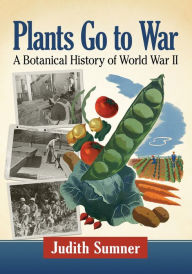DOWNLOAD [PDF] {EPUB} Plants Go to War: A Botanical History of World War II
Plants Go to War: A Botanical History of World War II. Judith Sumner

Plants-Go-to-War-A-Botanical.pdf
ISBN: 9781476676128 | 366 pages | 10 Mb

- Plants Go to War: A Botanical History of World War II
- Judith Sumner
- Page: 366
- Format: pdf, ePub, fb2, mobi
- ISBN: 9781476676128
- Publisher: McFarland & Company, Incorporated Publishers
Ebooks free download for mobile Plants Go to War: A Botanical History of World War II by Judith Sumner (English literature)
As the first botanical history of World War II, Plants Go to War examines military history from the perspective of plant science. From victory gardens to drugs, timber, rubber, and fibers, plants supplied materials with key roles in victory. Vegetables provided the wartime diet both in North America and Europe, where vitamin-rich carrots, cabbages, and potatoes nourished millions. Chicle and cacao provided the chewing gum and chocolate bars in military rations. In England and Germany, herbs replaced pharmaceutical drugs; feverbark was in demand to treat malaria, and penicillin culture used a growth medium made from corn. Rubber was needed for gas masks and barrage balloons, while cotton and hemp provided clothing, canvas, and rope. Timber was used to manufacture Mosquito bombers, and wood gasification and coal replaced petroleum in European vehicles. Lebensraum, the Nazi desire for agricultural land, drove Germans eastward; troops weaponized conifers with shell bursts that caused splintering. Ironically, the Nazis condemned non-native plants, but adopted useful Asian soybeans and Mediterranean herbs. Jungle warfare and camouflage required botanical knowledge, and survival manuals detailed edible plants on Pacific islands. Botanical gardens relocated valuable specimens to safe areas, and while remote locations provided opportunities for field botany, Trees surviving in Hiroshima and Nagasaki live as a symbol of rebirth after vast destruction.
Sherman tank | Description, History, & Facts | Britannica.com
A total of 49,324 Sherman tanks were produced in 11 plants between 1942 and 1946. The first American main battle tank employed in combat in World War II was the M3 It is likely that no tank in history ever went from design to production faster than the A typical power plant was a 425-horsepower gasoline engine.
HIST 3544 » Talk — Zooniverse
The Digital History Project provided a great experience with working with The It is helping to raise awareness on the experiences of American GIs during World War II. of the documents said and did not even come close to what majority said. I never thought the soldiers had such huge emotions about the war and not
Leontopodium nivale - Wikipedia
Leontopodium nivale, commonly called edelweiss is a mountain flower belonging to the daisy or sunflower family Asteraceae. The plant prefers rocky limestone places at about 1,800–3,000 metres Alpen Edelweiß, Leontopodium alpinum 2. . During World War I (1915), the edelweiss was granted to the German alpine
Canola oil - Wikipedia
Canola oil, or canola for short, is a vegetable oil derived from a variety of rapeseed that is low in erucic acid, as opposed to colza oil. There are both edible and industrial forms produced from the seed of any of several cultivars of the plant family Brassicaceae, namely cultivars of Brassica napus World War II caused high demand for the oil as a lubricant for the rapidly
World War II National Historic Landmarks: The Aleutian Campaign
Many World War II period buildings have been rehabilitated for commercial and private use. local community has a strong commitment to local history and Aleut culture. Secretly built and disguised as a fish packing plant, Fort Glenn . Go! Loading results 807th Battalion History, part 3: Attu and Misc.
Bombing of Bremen in World War II - Wikipedia
Main articles: Strategic bombing during World War II and History of Bremen. The Bombing of Bremen in World War II by the British Royal Air Force and US Eighth Air Force Borgward motor transport plants . Borgward and Goliath plants producing armored fighting vehicles and the Focke-Wulf Fw 190 components plant.
Hort Therapy - Tucson Botanical Garden
A Brief History of Horticultural Therapy; Horticultural Therapy at Tucson
Victory Gardens in World War II - Sarah Sundin
For the average American in World War II, the Victory Garden was a encouraged to grow their own produce to supplement their rations. Farmers were encouraged to plant gardens for family needs as well as their usual cash crop. . Today in World War II History—July 7, 1944 · Today in World War II
Historical review of medicinal plants' usage - NCBI
Keywords: History, medicinal plants, plant drugs, usage [2] Nonetheless, the decreasing efficacy of synthetic drugs and the increasing helenium L. Asteraceae) was named in honor of Elena, who was the centre of the Trojan War. . medicinal value, and they have persisted in all pharmacopoeias in the world till today.
Links:
TEMPLARIOS. EN BUSCA DEL SANTO GRIAL leer epub
DOWNLOADS The Light Brigade
TRILOGÍA DEL INFINITO EBOOK | ANGELICA LIDDELL | Descargar libro PDF EPUB
Download Pdf Foundations of Mental Health Care / Edition 7
0コメント